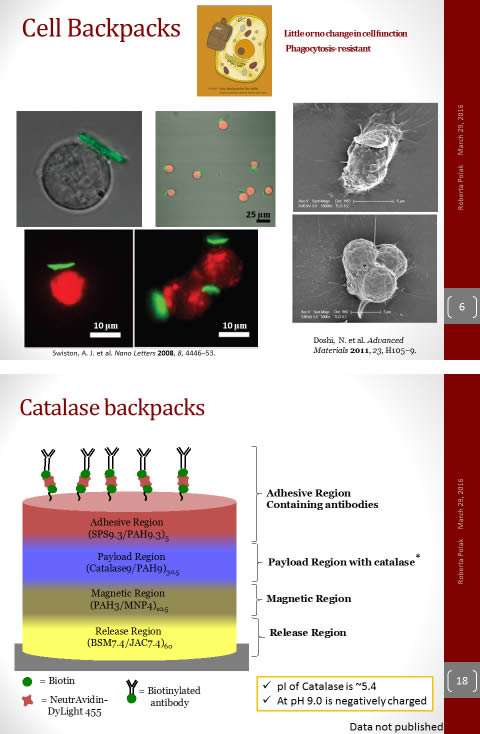 Participants: Roberta Polak, Reginaldo Gomes
Participants: Roberta Polak, Reginaldo Gomes
Collaboration with Michael Rubner MIT DMSE and with Elena Batrakova, University of North Carolina, Eshelman School of Pharmacy
Funding from the National Science Foundation
In 2012 we obtained a patent (US 8323637 Swiston, et al) that covers very broadly the concept of attaching thin-film backpacks to the surface of living cells with essentially no adverse effects on cell function. The backpacks are ultra-thin stratified film patches (several microns diameter) that contain a payload (eg a drug), a cell attachment layer, a release layer (to enable removal from the substrate platform used to make the thin-film patches), and possibly other strata for various purposes. The stratified thin films are produced by layer-by-layer assembly (LBL).
In the past we have pursued certain applications for this novel functionalized-cell concept, including one collaboration with Samir Mitrgotri from UCSB. (Journal of Controlled Release 199, 29 2015). The focus of that application was ‘targeted drug delivery’ wherein the cells bring the attached backpacks, with payload, to desired regions in laboratory mice, eliminating unwanted global dosing of the animal.
We have recently transformed our focus towards embedding of enzymes into the backpacks. This has led us to collaborate with a team of researchers at University of North Carolina (led by Elena Batrakova) who are interested in delivering therapeutic agents, specifically including the enzyme catalase, to the brain. This of course requires successful passage of the catalase across the blood-brain barrier.
Recent results have been disclosed in a provisional Patent Application No.62/308,803, March 15, 2016 which demonstrates that we can load catalase successfully into large area films as well as into our ten-micron diameter backpacks, at meaningful concentrations. The enzymatic activity of the catalase-loaded backpacks is retained, even though the enzyme is fully embedded in our LbL film constructions.We have developed the needed conjugation chemistry to attach the catalase-loaded backpacks to monocyte cells, a class of immune cells known for their ability to migrate across the blood brain barrier. Preliminary experiments at UNC demonstrate that monocytes are able to carry our catalase-loaded backpacks across a model (in-vitro) blood-brain barrier as well as into the brains of suitably-challenged laboratory mice. Certain control experiments and replications are ongoing.
